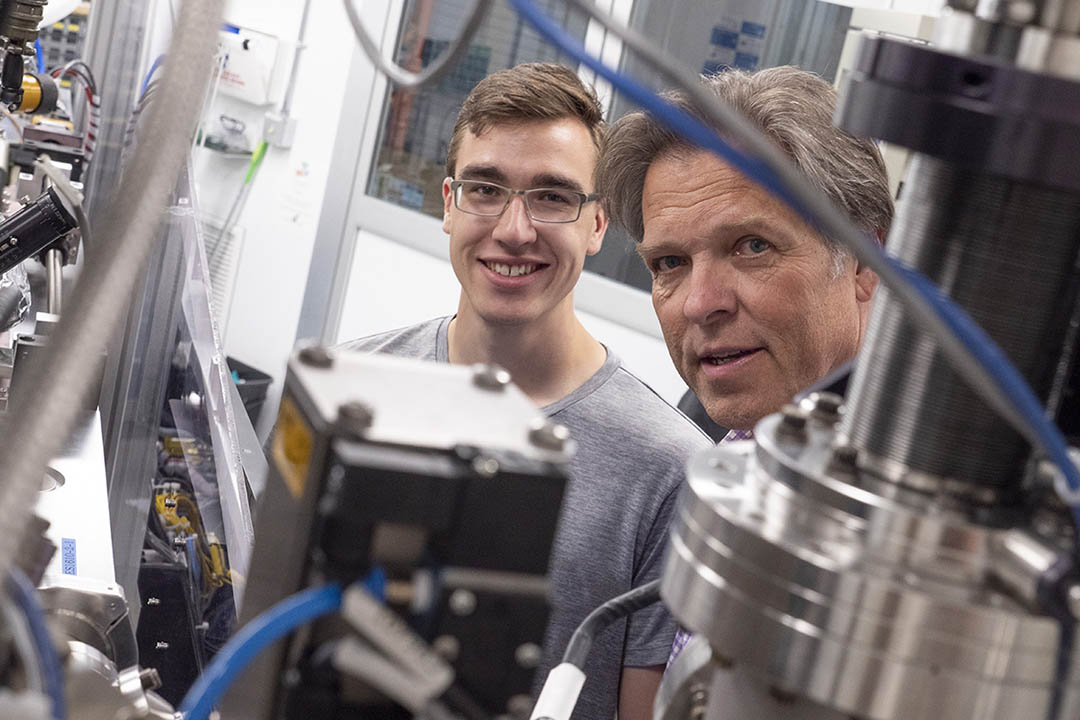
USask research uncovers new insights into nitrogen, phosphorous and their neighbours
SASKATOON – Nitrogen may be the most common element in the air that we breathe, but it and nearby elements on the periodic table still hold great mysteries to uncover. Thanks to separate University of Saskatchewan (USask) research projects led by Canada Research Chairs, the nature of pnictogens—including nitrogen, phosphorous, and antimony—and how they interact with other elements is becoming clearer.
A research team led by USask researcher in physics and engineering physics, Dr. Alexander Moewes (PhD), Canada Research Chair in Materials Science with Synchrotron Radiation, is investigating a brand-new compound—potentially leading to new material properties such as ultra-hardness and luminescence.
“There’s not one, single ‘home run’ application, but it’s a big step forward,” said Moewes.
At 800oC and at pressure nearly 60,000 times greater than normal atmospheric conditions on Earth, research collaborators at Ludwig-Maximilians-University Munich (LMU) succeeded in creating a new, never-before-seen compound by ramming together nitrogen and phosphorous with germanium—a hard, lustrous, grey element related to silicon and carbon.
Moewes’ research team, including post-doctoral fellow Dr. Tristan de Boer (PhD) and undergraduate student Cody Somers, then analyzed this new compound experimentally at the team’s beamline at USask’s Canadian Light Source (CLS) synchrotron, finding it had two electrons in its outer shell that did not bond – so-called “lone pairs.” This is the first time that lone pairs have been observed with germanium in nitrogen-phosphorous compounds.
“Outer electrons—or valence electrons—typically bond, but these lone pair electrons do not participate in bonding, and can be used to tailor properties of materials,” said Moewes.
The research, which was published in Angewandte Chemie, established through calculations that there was an imbalance in the structure of the material due to the lone pair, making this compound structurally different from every other similar compound.
“You have this large, enclosed channel, like an empty straw in the material,” said de Boer. “In this case, the lone pairs are kind of stabilizing it.”
The USask team then used synchrotron light at the CLS, bombarding the substance with X-rays to understand its structure, and confirming it had a pair of non-bonding electrons, as anticipated. The results were published in Journal of Materials Chemistry A.
The findings open a door to developing a new variety of advanced materials in the same class as the hardest materials on Earth, as well as holding promise to create new semiconductors and new insulators, and other materials that take advantage of this type of material’s unique structure.
“The Holy Grail is that we gradually deepen our understanding, and we can then ideally design materials on the computer first, to then ultimately realize them in the lab,” said Moewes.
Moewes’ research was funded by Canada’s Natural Sciences and Engineering Research Council (NSERC) grants, including an NSERC Undergraduate Student Research Award for Somers, and funding from the Canada Research Chair Program.
Antimony stands alone

Another USask research team is digging deeply into antimony—another member of the pnictogen family—to develop an increased understanding of basic chemistry. Antimony is significant as a potential environmental toxin—some antimony compounds are more toxic than arsenic and are found in materials like the plastics used in soft drink bottles.
it can also exist as a single unit without being chained together, as with the other elements in Group 15—nitrogen, phosphorous, and arsenic. Antimony oxide was previously understood to only exist in repeating chains, and not as a monomer—a standalone molecule.
“This was something that had not been previously observed—until now, antimony was an outlier among the pnictogens,” said USask geological sciences researcher Dr. Graham George (DPhil), Canada Research Chair in X-ray Absorption Spectroscopy. “The observation is really important in understanding the chemistry of group trends.”
The monomer form—a solid, white substance with a yellow hue—was created in a laboratory at University of California Santa Cruz by George’s collaborators, Dr. Timothy Johnstone (PhD) and graduate student John Wenger. From UC Santa Cruz, the substance was wrapped in a specially-designed carbon bowl—a trap to prevent the monomers from joining together—and shipped to Stanford University’s synchrotron for X-ray absorption analysis by George and graduate student Monica Weng.
The next steps in George’s research involve using different synchrotron techniques to do deeper analysis of the antimony-based compounds to better understand their electron structure.
George’s research was supported by , the Canada Research Chair program, University of Saskatchewan (GNG), United States Departm of Energy Basic Energy Sciences program, United States National Institutes of Health, and the National Science Foundation.
-30-
For media inquiries, contact:Victoria Dinh
USask Media Relations
306-966-5487
victoria.dinh@usask.ca

